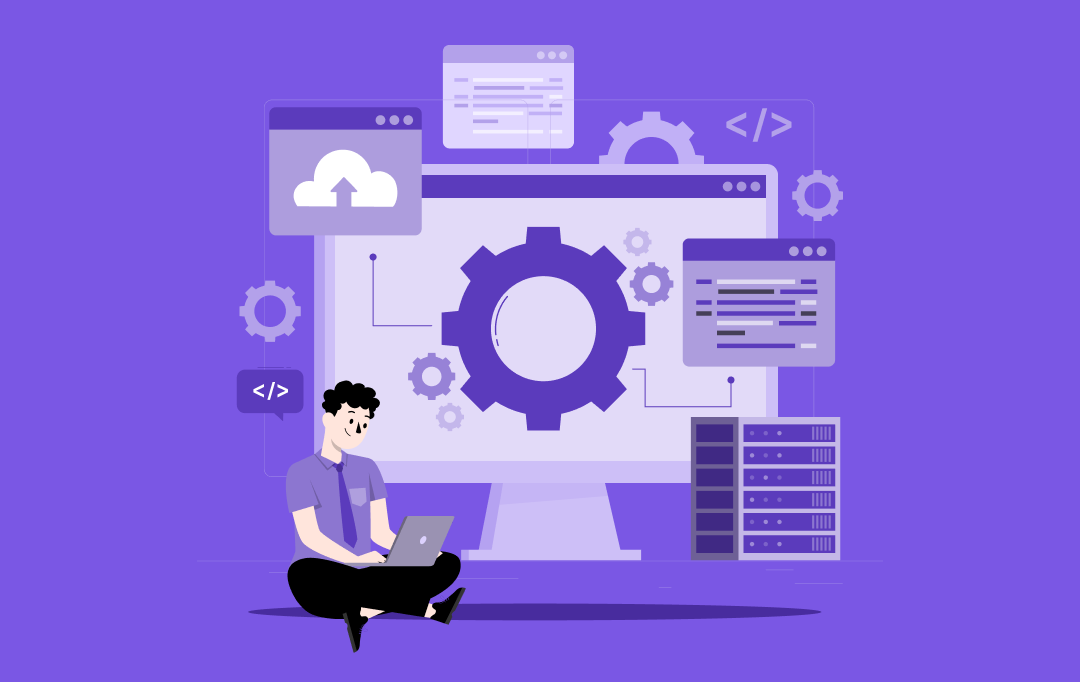As we are stepping into 2025, businesses are more reliant than ever on digital technologies, reshaping how they operate, communicate, and deliver value to customers. Like good things come with risks, digital inventions also come with a few challenges and risks—especially in cybersecurity for businesses.
Every connected device, from smartphones to laptops, represents a potential entry point for cybercriminals looking to exploit vulnerabilities. The cyber-world is full of theft, data breaches, and fraud, which are constant threats. Businesses must prioritize robust cybersecurity to safeguard their operations, customers, and reputations.
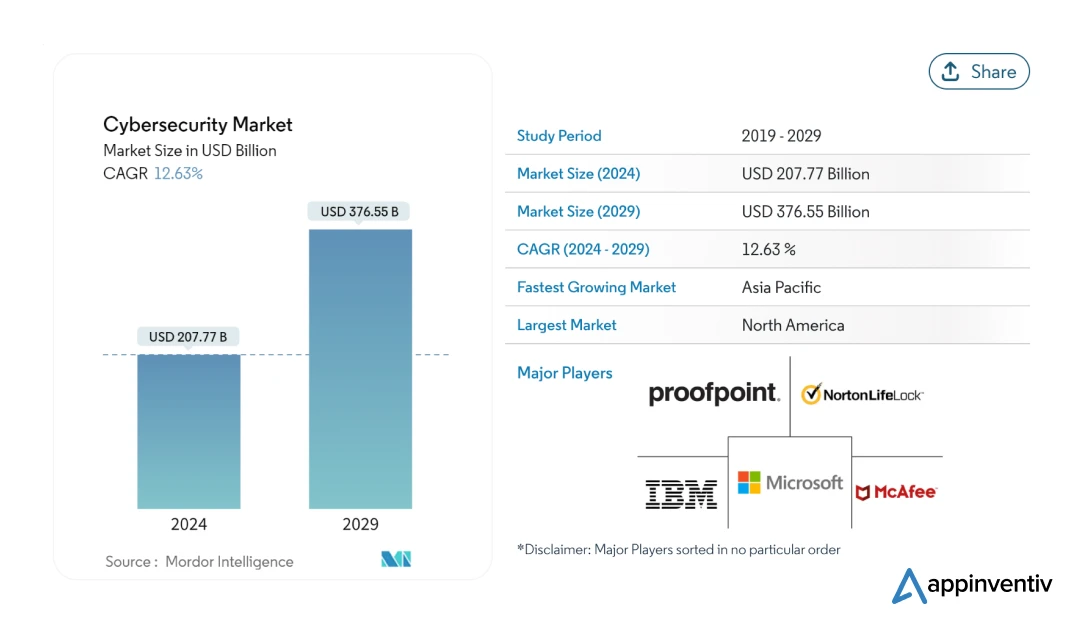
The global cybersecurity market is projected to be valued at $207.77 billion by the end of 2024 and is anticipated to grow to $376.55 billion by 2029, reflecting a CAGR of 12.63% over the forecast period (2024-2029).
This rapid growth underscores the increasing importance of cybersecurity as businesses continue to adopt digital solutions and shift to online platforms.
Let’s delve into the evolving landscape of cybersecurity threats in 2025 and explore cybersecurity measures that safeguard digital data in this new era.
Decoding Cyberattacks: Types and Their Impact on Security
Cyberattacks pose a significant threat to organizations of all sizes and sectors. Understanding the various types of cyberattacks and their potential impact on security is crucial for developing effective defense strategies. From phishing schemes to ransomware, these attacks exploit vulnerabilities in systems, networks, and even human error.
According to Statista, businesses worldwide encountered data loss, financial damage, and reputational harm as the most common consequences of sensitive information breaches in 2023.
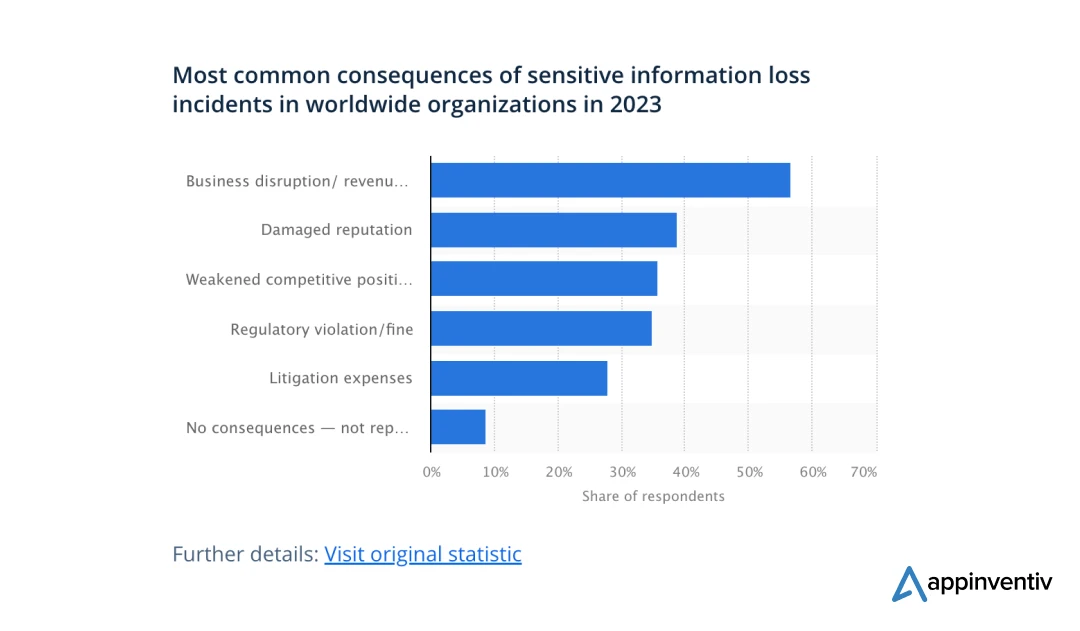
Let’s comprehend about the common cyberattack types and their impact:
- Phishing Attacks: Phishing attacks involve deceiving individuals into providing sensitive information by masquerading as trustworthy entities.
Impact: These attacks can lead to data breaches, identity theft, and financial loss. They can also compromise organizational integrity and erode customer trust.
- Malware: Malware encompasses various malicious software types, including viruses, worms, and ransomware.
Impact: Malware can disrupt operations, steal sensitive data, or encrypt files for ransom, demanding payment for their release. The cost of recovery can be substantial, both financially and in terms of reputation, and breaches cybersecurity for businesses.
- Denial-of-Service (DoS) Attacks: DoS attacks overwhelm a system with traffic, rendering it unavailable to legitimate users.
Impact: This can lead to significant downtime, loss of revenue, and damage to customer trust. Repeated attacks can weaken a company’s online presence and brand reputation.
- Man-in-the-Middle (MitM) Attacks: MitM attacks occur when an attacker intercepts and alters communication between two parties without their knowledge.
Impact: This can result in the theft of sensitive information, such as login credentials and personal data, compromising the privacy and security of both parties involved.
- Ransomware Attacks: Ransomware encrypts a victim’s data and demands payment for the decryption key.
Impact: These attacks can paralyze organizations, leading to significant financial losses, reputational damage, and potential legal liabilities.
- SQL Injection: SQL injection attacks exploit vulnerabilities in web applications by injecting malicious SQL code to manipulate databases.
Impact: Attackers can access, modify, or delete sensitive data, leading to breaches and regulatory penalties.
- Credential Stuffing: Credential stuffing involves using stolen credentials from one service to gain unauthorized access to another We can enhance protection by using cloud email security to block threats in real time..
Impact: This can result in account takeovers, data breaches, and unauthorized transactions, further amplifying the damage across multiple platforms.
Unlocking the Benefits of Cybersecurity for Business in 2025: Building Resilience and Trust
Investment in strong cybersecurity practices can give organizations a considerable advantage by building trust, protecting sensitive information, and ensuring compliance in our rapidly digitizing world. Let’s examine the essential extensive benefits of cybersecurity for business it brings to achieving success.
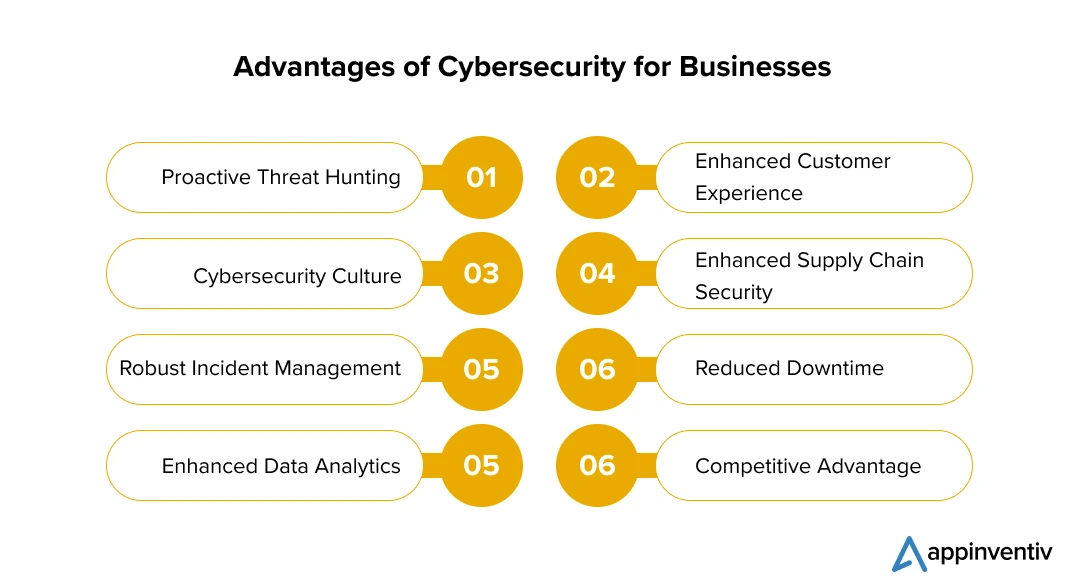
Proactive Threat Hunting
In 2025, proactive threat hunting will become an essential aspect of cybersecurity strategies. Organizations will invest in dedicated teams to actively seek out vulnerabilities and potential threats before they can be exploited. This proactive approach allows businesses to address weaknesses in their systems, significantly strengthening cybersecurity for businesses and providing cybersecurity solutions. . .
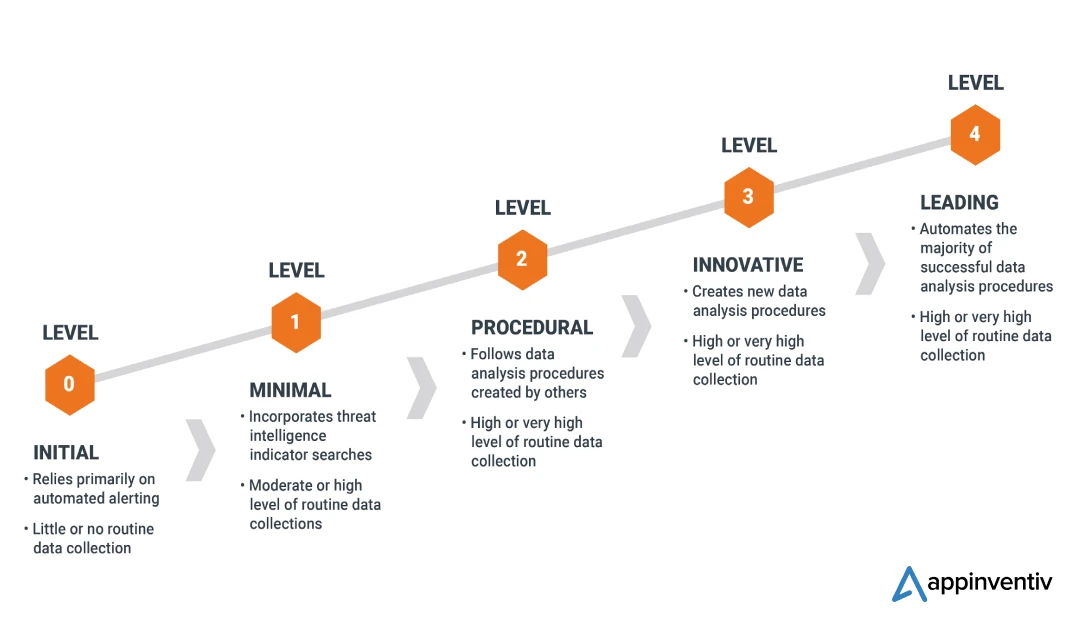
Enhanced Customer Experience
With robust cybersecurity measures, businesses can offer customers a safer online experience. Organizations can enhance user trust and satisfaction by protecting personal and financial information. This focus on security attracts new customers and helps retain existing ones, fostering long-term relationships based on confidence and reliability. This ultimately highlights the importance of investing in solutions for cyber security to secure a successful future for businesses and their customers.
Cybersecurity Culture
Fostering a strong cybersecurity culture within an organization will be vital in 2025. When employees understand the importance of cyber security for company operations and their role in maintaining it, they become active participants in defending against cyber security threats to business.
Training and awareness programs will empower staff to recognize risks and act accordingly, creating a more resilient organization.
Enhanced Supply Chain Security
As businesses increasingly rely on third-party partners, ensuring supply chain security will be crucial. Cybersecurity measures for businesses will extend beyond the organization to include suppliers and partners, mitigating shared data and services risks. By implementing stringent security protocols across the supply chain, businesses can protect against potential vulnerabilities introduced by external entities and cyber security threats to businesses.
Robust Secured Incident Management
Effective incident management will be a key benefit of cybersecurity in 2025. Organizations will develop comprehensive incident response plans that outline clear procedures for identifying, responding to, and recovering from cyber incidents. This preparedness and anticipation of potential cybersecurity threats and measures ensure businesses can minimize damage and restore normal operations swiftly, protecting their reputation and bottom line.
Reduced Downtime
Investing in cybersecurity for businesses will help reduce downtime caused by cyber incidents. With advanced threat detection and response capabilities, organizations can quickly address and mitigate threats, minimizing disruptions to business operations. This efficiency not only enhances productivity but also supports overall business continuity.
Enhanced Data Analytics
Cyber security for companies will increasingly incorporate advanced data analytics to provide actionable insights into potential threats. Thus, businesses can potentially identify the vulnerabilities and risks before they occur and strategize their mitigations. This data-driven approach enhances overall security posture and enables informed decision-making.
Competitive Advantage
Finally, having robust cybersecurity measures for businesses will provide a competitive advantage in the market. Companies that prioritize cybersecurity are likely to gain the trust of customers and partners, setting themselves apart from competitors. In a landscape where consumers are increasingly concerned about data privacy and security, organizations that can demonstrate strong solutions for cyber security will stand out and attract more business.
Top 10 Cybersecurity Measures for Businesses in 2025
In 2025, robust cybersecurity measures for businesses are necessary and a strategic priority for safeguarding sensitive data and maintaining operational resilience.
Explore the top 10 measures to fortify your business against potential cyberattacks.
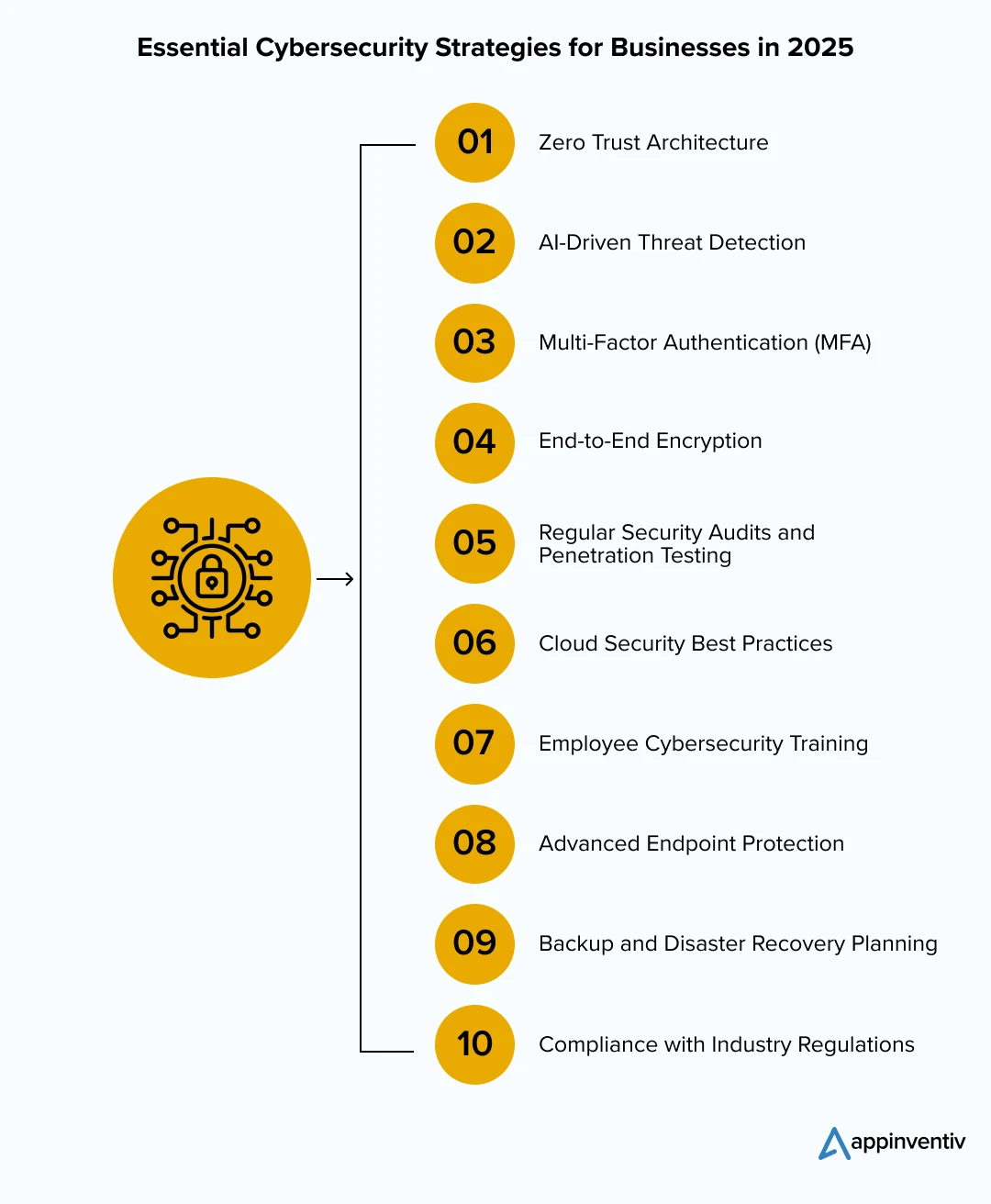
Zero Trust Architecture
Now, businesses understand the gravity of the cyber situation and have replaced the conventional security model with a modern approach—Zero Trust Architecture.
It is emerging as a necessity, where trust is never assumed. Instead, every user, device, and application attempting to access a network resource is continuously verified and authenticated, irrespective of their location—inside or outside the network.
By segmenting access and applying the principle of least privilege, businesses can reduce the attack surface and minimize lateral movement within their systems.
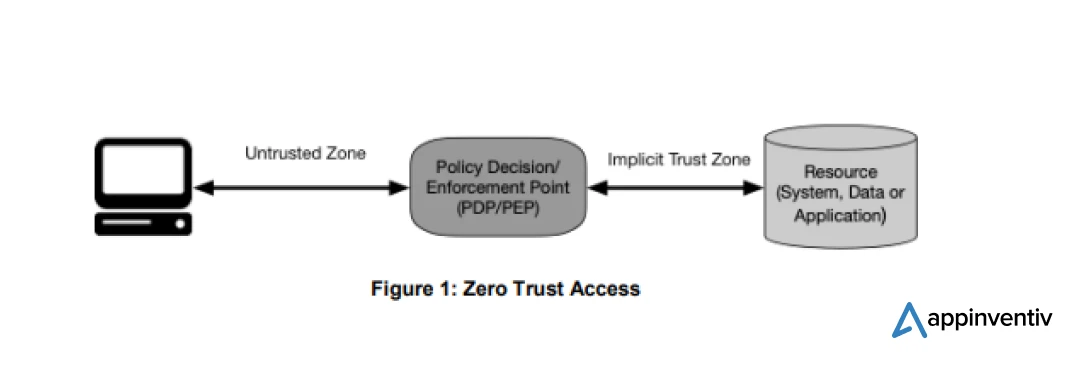
Zero trust model integrates well with cloud environments, making it a flexible, future-proof security strategy. This is one of the key use cases of cybersecurity in business, as it helps organizations ensure that every user and device, regardless of location, is continuously verified and authenticated before accessing resources.
AI-Driven Threat Detection
AI-driven threat detection is critical for staying ahead with speedy resolution. AI systems monitor network traffic, identify patterns, and learn from previous attacks to proactively detect and mitigate threats in real-time.
By leveraging machine learning and deep learning algorithms, these systems become smarter over time, identifying subtle anomalies that human analysts might miss. AI enhances threat detection and incident response, allowing for predictive analysis of potential vulnerabilities and ensuring businesses can neutralize threats before they materialize into full-blown attacks.
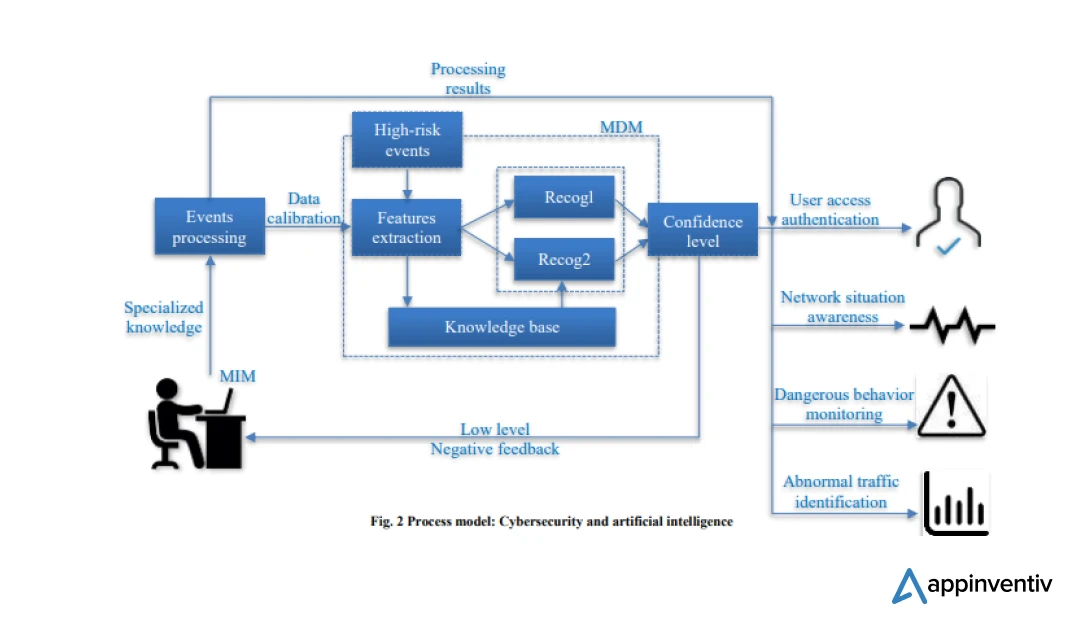
Multi-Factor Authentication (MFA)
In an era of rampant password breaches, relying on passwords alone is highly risky. Multi-Factor Authentication (MFA) adds a crucial layer of defense by requiring users to provide multiple forms of verification before gaining access to sensitive systems. This might include a combination of passwords, biometrics (like fingerprints or facial recognition), and device-based tokens.
Even if a password is compromised, attackers still need a secondary verification form to gain access. MFA is a simple yet powerful tool for safeguarding against unauthorized entry and is a core requirement for protecting sensitive business data in 2025.
End-to-End Encryption
End-to-end encryption is crucial for safeguarding sensitive data in transit, especially as more business operations move online and into the cloud. In 2025, businesses will rely on encryption to ensure that their data, whether financial transactions, medical records, or confidential business communications, is unreadable to anyone except the intended recipient. This encryption ensures that it remains protected and secure even if hackers intercept the data during transmission. As cybercriminals continue exploiting vulnerabilities in unencrypted communications, businesses must adopt end-to-end encryption as a standard practice.
Regular Security Audits and Penetration Testing
Staying secure is not about implementing a static solution but continuous improvement and vigilance. Regular security audits ensure that businesses are not only adhering to industry standards but also identifying and addressing any potential vulnerabilities in their systems.
Penetration testing, or ethical hacking, allows businesses to simulate real-world attacks, providing insights into weak points that could be exploited by malicious actors. By frequently updating these practices, businesses in 2025 can stay ahead of evolving threats, adapt to regulatory changes, and ensure their defenses are resilient against emerging cyber risks.
Cloud Security Best Practices
With more businesses migrating to the cloud, safeguarding cloud environments will become paramount by 2025. Cloud security best practices for preventing cyberattacks include securing cloud configurations, encrypting data, applying identity and access management (IAM) controls, and using automation to monitor cloud infrastructure continuously. In this shared responsibility model, cloud service providers and organizations must work together to protect data, applications, and services. Businesses also need to account for potential misconfigurations, a leading cause of cloud breaches.
Implementing strong cloud security protocols will protect data integrity, availability, and confidentiality, fostering secure digital transformation while integrating cybersecurity tips for businesses into everyday practices.
Employee Cybersecurity Training
A chain is only as strong as its weakest link; often, that weak link is the human element. Cybersecurity training for employees is essential in 2025 as cybercriminals increasingly target individuals through phishing and social engineering.
Regular and updated ms cybersecurity online training helps employees recognize common threats like phishing scams, insecure links, or suspicious emails. This also creates a culture of cybersecurity awareness for businesses, where employees become the first line of defense. Encouraging best practices, like using secure passwords, identifying potential threats, and reporting suspicious activities, will significantly lower the risk of internal security breaches.
Advanced Endpoint Protection
With remote and hybrid work environments becoming the norm, protecting every endpoint—such as laptops, smartphones, and tablets—has become critical. Advanced Endpoint Protection (AEP) goes beyond traditional antivirus software, incorporating AI-driven analysis, real-time threat detection, and advanced malware protection.
By 2025, businesses will need to secure not just corporate devices but also personal devices accessing corporate networks. AEP is one prominent example of cybersecurity for business. AEP solutions will ensure that these devices are continuously monitored, patched, and defended against new and evolving threats like ransomware and zero-day attacks, ensuring the integrity of the broader business network.
Backup and Disaster Recovery Planning
Ransomware and other devastating cyberattacks make backup and disaster recovery plans essential for business continuity in 2025. Regular, automated backups ensure that critical data can be recovered without paying ransom demands, and disaster recovery planning helps minimize downtime in case of an attack. Businesses should store backups in secure, offsite locations, which must be frequently tested to ensure their reliability. A robust disaster recovery strategy is one of the essential use cases of cybersecurity in business that allows companies to bounce back quickly, ensuring that operations continue with minimal disruption, no matter how severe the attack.
Compliance with Industry Regulations
With data privacy becoming a hot-button issue, adhering to industry-specific regulations and compliance frameworks will be mandatory by 2025. Regulations like GDPR, HIPAA, and CCPA impose strict guidelines for handling customer data, including data encryption, access controls, and incident reporting. Non-compliance can lead to hefty fines, reputational damage, and legal actions.
Businesses must ensure that their cybersecurity measures align with local and international regulations, continuously adapting as laws evolve. Compliance strengthens cybersecurity measures for enterprises and builds trust with customers, showcasing a commitment to data security and privacy.
Strengthening Business Resilience: Cybersecurity Solutions Across the Globe
In an era where cyber threats are a constant concern, industries worldwide are stepping up their game by adopting robust cybersecurity tips for businesses tailored to their unique challenges.
- Finance: The financial sector harnesses cutting-edge encryption technologies and multi-factor authentication to safeguard sensitive customer information and maintain trust in digital transactions.
- Healthcare: Healthcare providers are leveraging AI-driven threat detection systems that sift through massive datasets to spot anomalies and potential breaches, ensuring patient data remains secure.
- Manufacturers: Manufacturers are not left behind. They implement advanced security measures for their industrial control systems, like network segmentation and real-time intrusion detection, to protect vital operations from cyberattacks.
- Retailers: In retail, businesses are enhancing their defenses with secure payment gateways and point-of-sale (POS) security solutions, protecting consumer data during every transaction.
- Energy Sector: The energy sector also prioritizes cybersecurity by focusing on operational technology (OT) security, which is crucial for protecting IoT devices and ensuring the reliability of essential services.
These proactive cybersecurity strategies not only shield sensitive information but also fortify overall business resilience, enabling organizations to thrive amidst the ever-evolving threat landscape.
Cutting-Edge Cybersecurity Tools & Technologies
The year 2025 is set to be pivotal for businesses as cybercrime continues to escalate, posing significant threats across various industries. With the rise in sophisticated attacks, organizations increasingly prioritize robust cybersecurity measures for businesses to protect their valuable information and maintain operational integrity.
As a result, many are leveraging cutting-edge tools and technologies to strengthen their defenses and mitigate risks. Let’s take a closer look at these essential cybersecurity tools and technology that can help businesses safeguard against emerging threats.
Let’s comprehend it through a chart:
| Cybersecurity Tools & Technology |
Description |
Examples |
| Security Information and Event Management (SIEM) |
Collects and analyzes security data for threat detection and compliance. |
Splunk, IBM QRadar, LogRhythm |
| Intrusion Detection and Prevention Systems (IDPS) |
Monitors network traffic for suspicious activities and blocks/reports potential threats. |
Snort, Cisco IDS/IPS, Suricata |
| Data Loss Prevention (DLP) |
Protects sensitive data from unauthorized access and exfiltration through policy enforcement. |
Symantec DLP, McAfee Total Protection for DLP, Digital Guardian |
| Web Application Firewalls (WAF) |
Monitors and filters HTTP traffic to protect web applications from attacks. |
Imperva, AWS WAF, F5 BIG-IP Application Security Manager |
| Identity and Access Management (IAM) |
Manages user identities and access to resources for security and compliance. |
Okta, Microsoft Azure AD, Ping Identity |
| Vulnerability Management Tools |
Identifies, assesses, and prioritizes vulnerabilities in software and systems. |
Qualys, Nessus, Rapid7 |
| Secure Web Gateways (SWG) |
Protects users from web-based threats by enforcing security policies. |
Zscaler, Symantec Web Security Service, Cisco Umbrella |
| Network Access Control (NAC) |
Ensures only authorized devices can access the network. |
Cisco Identity Services Engine, Aruba ClearPass, ForeScout |
| Threat Hunting Platforms |
Actively seeks out threats that may have bypassed traditional security defenses. |
CrowdStrike Falcon, Cybereason, Huntress |
| Mobile Device Management (MDM) |
Manages and secures mobile devices used in an organization. |
VMware Workspace ONE, MobileIron, Microsoft Intune |
| Email Security Solutions |
Protects against email-based threats such as phishing and malware. |
Mimecast, Proofpoint, Barracuda Email Security |
| Forensic Analysis Tools |
Investigates security incidents by analyzing digital evidence and recovering data. |
EnCase, FTK Imager, X1 Social Discovery |
| Behavioral Analytics Tools |
Analyzes user behavior to detect anomalies indicating potential threats. |
Exabeam, Sumo Logic, Balbix |
| Secure Access Solutions |
Provides secure access to applications and data without a VPN. |
Cloudflare Access, Zscaler Private Access, Google BeyondCorp |
| Risk Management Solutions |
Helps organizations identify, assess, and prioritize risks related to cybersecurity threats. |
RSA Archer, LogicManager, RiskWatch |
Process of Implementing Cybersecurity in Business
Implementing cybersecurity in business involves a comprehensive strategy, thorough analysis, and key elements that enable organizations to establish a secure and resilient infrastructure. Let’s dive in!
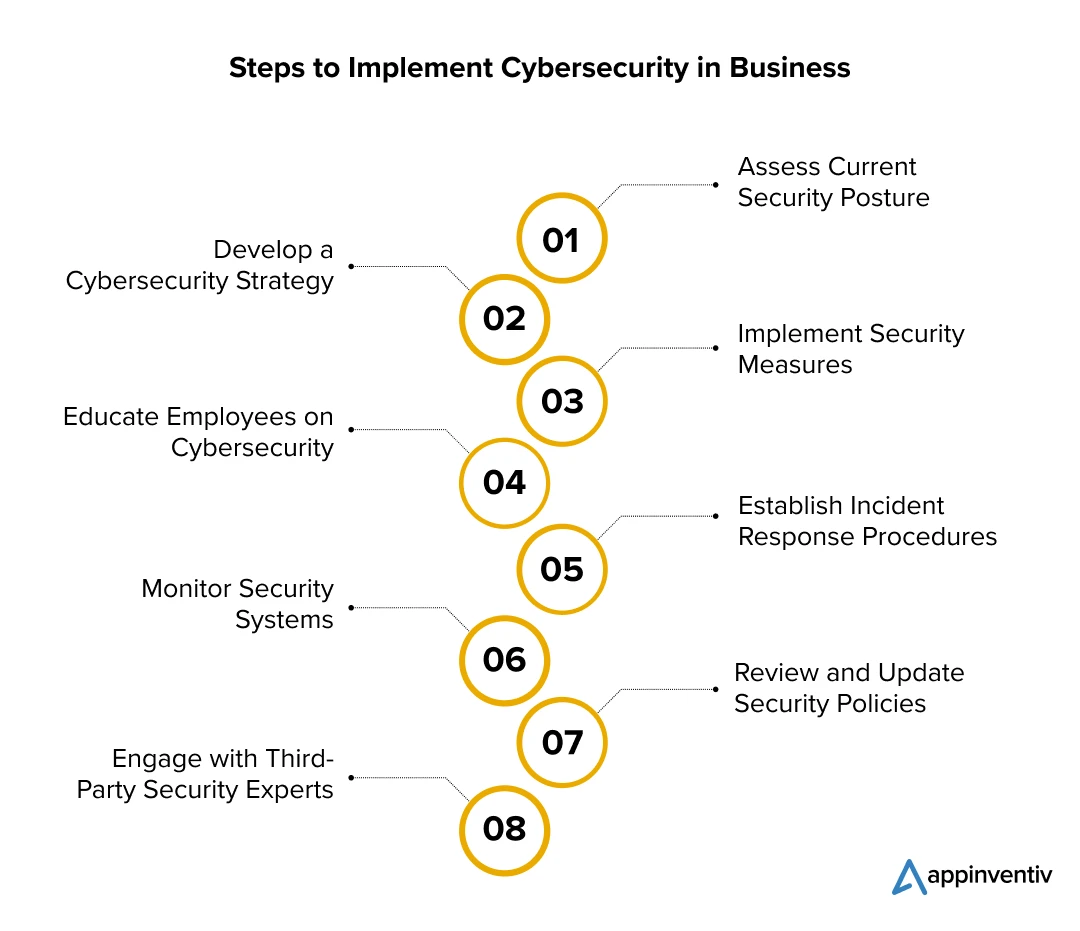
Assess Current Security Posture
The first step in implementing cybersecurity is to assess the organization’s current security posture. This involves cataloging all assets, including hardware, software, and data, to identify what needs protection.
Conducting a thorough risk assessment helps pinpoint vulnerabilities and potential threats. Additionally, organizations should review compliance with relevant regulations and industry standards to ensure they meet legal obligations.
Develop a Cybersecurity Strategy
After assessing the current security posture, the next step is to develop a comprehensive cybersecurity strategy. This includes defining clear objectives that align with the organization’s goals and creating policies for data protection, access controls, and incident response. Assigning roles and responsibilities is crucial, ensuring that a dedicated team or officer is in place to oversee and maintain security efforts. This strategic framework serves as a roadmap for all cybersecurity initiatives.
Implement Security Measures
With a strategy in place, businesses can implement essential security measures to safeguard their assets. This involves deploying various security tools, such as firewalls, antivirus software, and intrusion detection systems. Establishing strong access controls, including role-based access and multi-factor authentication, is vital for restricting data access to authorized personnel. Organizations should also focus on securing networks through proper configurations, segmentation, and continuous monitoring. This approach demonstrates the robust role of cybersecurity in business.
Educate Employees on Cybersecurity
Educating employees on cybersecurity best practices is crucial for enhancing overall security. Regular training sessions can help staff recognize phishing attempts, understand the importance of strong passwords, and learn safe data handling techniques.
Cultivating a culture of security awareness encourages employees to be proactive in identifying and reporting potential threats. This empowerment plays a significant role in cybersecurity in business, minimizing human error, a common cause of security breaches.
Establish Incident Response Procedures
Developing clear incident response procedures is essential for addressing potential security breaches effectively. Organizations should create an incident response plan that outlines the steps to be taken during a security incident, including identification, containment, eradication, and recovery.
Assigning roles and responsibilities within the response team ensures a coordinated effort during incidents. Regularly testing the incident response plan through simulations helps the team stay prepared for real-world scenarios.
Monitor Security Systems
Continuous monitoring of security systems is vital for detecting threats in real-time. Organizations should implement robust monitoring tools to identify unusual activities, unauthorized access attempts, or potential vulnerabilities.
Regular security audits can help assess the effectiveness of existing controls and reveal areas that need improvement. This proactive approach allows organizations to respond quickly to potential threats before they escalate into significant issues.
Review and Update Security Policies
Cybersecurity is ongoing; regularly reviewing and updating security policies is essential. Organizations should evaluate their policies in light of changing threats, technological advancements, and regulatory requirements. Gathering feedback from employees and stakeholders can provide insights into the effectiveness of current policies. This iterative approach ensures the cybersecurity framework remains relevant and effective in addressing emerging challenges.
Engage with Third-Party Security Experts
Finally, engaging with third-party security experts can provide valuable insights and enhance an organization’s cybersecurity posture. Consulting with cybersecurity firms can help identify blind spots and recommend best practices tailored to the organization’s needs. These experts can assist with vulnerability assessments, penetration testing, and compliance audits.
Partnering with specialists ensures that businesses remain informed about the latest threats and trends in cyber security for business, enabling them to adapt their strategies accordingly.

Emerging Trends Shaping the Future of Cybersecurity for Business
The future of cybersecurity for businesses is promising and essential, aiming to grow and enhance their operations. Let’s delve into the top trends in cybersecurity for 2025 in detail.
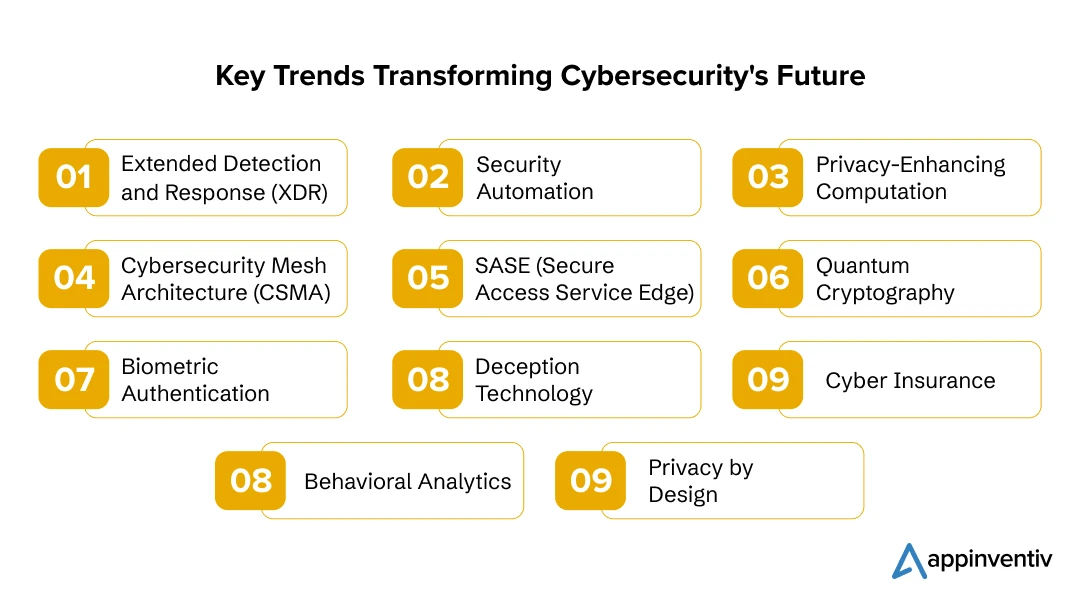
Extended Detection and Response (XDR)
This approach integrates multiple security products into a cohesive security operations strategy. It provides better visibility across endpoints, networks, and servers, enabling more efficient threat detection and response.
Security Automation
Automating repetitive tasks in cyber security for business, such as incident response and threat hunting, will become increasingly vital. This will improve efficiency and reduce the likelihood of human error by providing solutions to cyber security threats.
Privacy-Enhancing Computation
Techniques like federated learning and homomorphic encryption will gain traction, allowing organizations to analyze data without exposing sensitive information. This approach enhances privacy while still enabling the benefits of data analytics.
Cybersecurity Mesh Architecture (CSMA)
This approach to cybersecurity enables a more modular and scalable security posture for businesses. Organizations can establish security perimeters around individual assets instead of relying on a centralized security architecture. CSMA demonstrates holistic solutions to cyber security threats.
SASE (Secure Access Service Edge)
Combining networking and security into a single cloud-based service, SASE helps organizations secure remote access and connections for users regardless of location, prioritizing cyber security in business.
Quantum Cryptography
As quantum computing continues to develop, quantum cryptography will emerge as a new standard for securing data. It will leverage the principles of quantum mechanics to enhance encryption methods and strengthen cyber security in business.
Biometric Authentication
Beyond traditional MFA, biometric solutions (such as facial recognition, fingerprint scanning, and voice recognition) will become more widespread, providing more secure authentication methods that are difficult to replicate.
Deception Technology
This proactive defense mechanism creates traps and decoys within the network to detect and confuse attackers. Subsequently, this makes it more challenging for them to navigate the environment undetected.
Cyber Insurance
As cyber threats grow, more businesses consider cyber insurance a risk management strategy. This will lead to an increased focus on compliance and best practices to lower premiums and enhance coverage.
Behavioral Analytics
Leveraging machine learning and AI, organizations will adopt behavioral analytics to establish baselines for user behavior and detect anomalies that may indicate a security breach or insider threat.
Privacy by Design
More organizations will incorporate privacy considerations into their product and service designs from the outset, ensuring that data protection and user privacy are prioritized in their operations.
These trends reflect the dynamic nature of cyber security in business, emphasizing the need for organizations to remain agile and informed about emerging technologies and strategies to combat evolving threats effectively.
How Appinventiv Can Strengthen Your Cybersecurity Strategy
Managing cybersecurity for a business is not an easy nut to crack! You need a helping hand to develop powerful mitigation strategies to keep your business running securely and robustly. So, your search for that helping hand ends here at Appinventiv.
As a dedicated cybersecurity service provider, we specialize in creating tailored cybersecurity solutions that cater to your needs, ensuring your data remains protected.
At Appinventiv, we prioritize your cybersecurity needs by delivering tailored solutions that fortify your defenses against evolving threats. Here’s why we stand out:
- Comprehensive Security Assessments: Thoroughly evaluate your current framework to identify vulnerabilities and develop tailored strategies.
- Advanced Threat Detection and Response: Utilize AI and machine learning for real-time monitoring and swift breach response.
- Employee Training and Awareness: Foster a culture of cybersecurity hygiene through best practice training.
- Expertise in Secure Application Development: Integrate security protocols throughout the software development lifecycle for robust protection.
- Trust and Reliability: Proven track record in safeguarding digital assets, ensuring your security needs are met with expertise.
Partner with us to strengthen your cybersecurity strategy and build a resilient framework that supports your business growth while keeping cyber threats at bay.
FAQs
Q. Why is cyber security so important for businesses?
A. Cyber security for business is vital as it safeguards sensitive data and ensures regulatory compliance while maintaining customer trust. With the increasing sophistication of cyberattacks, protecting proprietary and personal information from breaches is essential. A data breach can lead to substantial financial losses, reputational damage, and regulatory fines, making proactive and innovative cybersecurity measures critical. Businesses must also be aware of common vulnerabilities that can expose them to risk. Weak passwords, phishing attacks, unpatched software, and insider threats can compromise security. By identifying and addressing these vulnerabilities, organizations can create a more robust cybersecurity framework to protect their operations and maintain their reputation.
Q. What are the common vulnerabilities that businesses need to be aware of?
A. Here are some common vulnerabilities businesses must be aware of:
- Weak Passwords: Many employees use easily guessable passwords or reuse passwords across multiple sites, making them susceptible to breaches.
- Phishing Attacks: Cybercriminals often use phishing emails to trick employees into revealing sensitive information or downloading malware.
- Unpatched Software: Failing to apply security patches and updates can leave systems vulnerable to exploitation.
- Insider Threats: Employees or contractors with malicious intent or who inadvertently expose sensitive data can pose significant risks.
- Insecure Networks: Using unsecured Wi-Fi networks or outdated hardware can increase cyberattack vulnerability.
- Lack of Security Awareness Training: Employees untrained in cybersecurity best practices can unknowingly compromise security through negligence.
Q. What role do third-party vendors play in a company’s cybersecurity strategy?
A. Third-party vendors are critical in a company’s cybersecurity strategy, as their access to sensitive information can introduce risks. Regular vendor assessments and compliance checks are necessary to mitigate these vulnerabilities.
To evaluate their cybersecurity posture, businesses can conduct security audits and risk assessments, utilizing penetration testing by ethical hackers to uncover weaknesses. Combining these strategies helps organizations enhance their innovative cybersecurity measures for businesses and reduce the risk of breaches.
Q. How often should businesses conduct cybersecurity audits or assessments?
A. The frequency of cybersecurity audits should depend on the industry’s specific risks and compliance requirements. Generally, an annual audit is a good baseline.
Still, organizations should also consider conducting assessments after significant changes in their IT environment, such as system upgrades, mergers, or data breaches.
This approach ensures that security measures remain robust and relevant to the organization’s current threat landscape.
Q. How can businesses assess their current cybersecurity posture?
A. To assess their current cybersecurity posture, businesses should start with a thorough risk assessment that identifies potential vulnerabilities within their systems and networks.
This process involves reviewing existing security policies, conducting vulnerability scans, and evaluating employee training on cybersecurity best practices. By gaining insights into their security strengths and weaknesses, businesses can prioritize areas for improvement.
Product Development & Engineering
IT Managed & Outsourcing
Consulting Services
Data Services
Didn't find what you're looking for? Let us know your needs, and we'll tailor a solution just for you.




